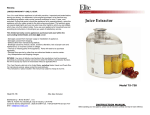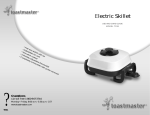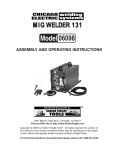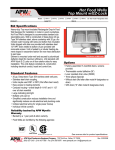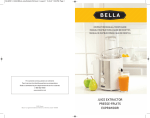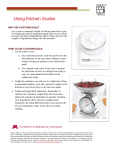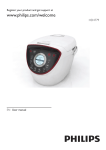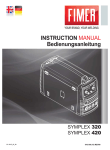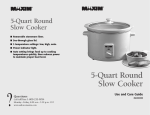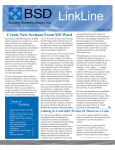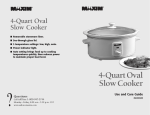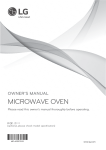Download Great Tips for Great Trays - University of Minnesota Extension
Transcript
Great Tips for Great Trays 2 Great Tips for Great Trays Table of Contents How to Hold a Chef’s Knife…………………………………………………………………………………. 5 Knife Cutting Techniques…………………………………………………………………………………….. 7 Types of Knives……………………………………………………………………………………………………. 9 Mise en Place………………………………………………………………………………………………………. 11 Washing Fresh Produce……………………………………………………………………………………….. 13 Dicing a Carrot…………………………………………………………………………………………………….. 15 Chopping or Dicing Celery…………………………………………………………………………………… 17 Preparing Jicama……………………..………………………………………………………………………….. 19 Cutting Head Lettuce…………………………………………………………………………………………… 21 Slicing or Chopping Melons………………………………………………………………………………….. 23 Chopping, Dicing, or Mincing Onions, Shallots, and Garlic…………………………………… 25 Slicing, Chopping, Dicing, or Mincing Bell Peppers………………………………………………. 27 Peeling and Slicing Butternut Squash…………………………………………………………………… 29 Measuring Liquid and Dry Ingredients Correctly…………………………………………………. 31 Measuring Flour………………………………………………………………………………………………….. 33 Using Kitchen Scales…………………………………………………………………………………………..…35 How to Calibrate a Thermometer………………………………………………………………………… 37 Checking Food Temperatures……………………………………………………………………………… 39 Setting Up a Work Station……………………………………………………………………………………. 41 Preparing Food Just-in-Time………………………………………………………………………………… 43 3 Legumes: Beans, Peas, and Lentils……………………………………………………………………….. 45 Preparing Dry Beans and Dry Whole Peas……………………………………………………………. 47 Basic Principles for Preparing Pasta…………………………………………………………………….. 49 Cooking Dry Pasta……………………………………………………………………………………………….. 51 Basic Principles for Preparing Rice………………………………………………………………………. 53 Cooking Rice……………………………………………………………………………………………………….. 55 USDA Commodity Food Fact Sheet: Brown Rice – 25 lb………………………………………. 57 USDA Commodity Food Fact Sheet: Brown Rice – 24/2 lb……………………………………. 59 Cooking Vegetables…………………………………………………………………………………………….. 61 How to Wrap Sandwiches……………………………………………………………………………………. 63 More Sandwich Wrapping Ideas………………………………………………………………………..… 65 Self-Service Bar Tips……………………………………………………………………………………………. 67 © 2011, Regents of the University of Minnesota. All rights reserved. Reviewed February 2013 by Hannah Miller, RD, Project Coordinator – Health and Nutrition. This booklet was developed in conjunction with the Great TraysTM Partnership by Trina Barno, Linda Dieleman, and Mary Caskey, Extension Educators – Health and Nutrition. University of Minnesota Extension is an equal opportunity educator and employer. In accordance with the Americans with Disabilities Act, this material is available in alternative formats upon request. Direct requests to 612-626-6602. For more information on Great Trays™, visit http://www1.extension.umn.edu/family/health-and-nutrition/school-foodservice-training-andresources/great-trays/. 4 How to Hold a Chef’s Knife Your non-knife hand is called your guiding hand. Its job is to hold food steady on the cutting board and prevent injury! Keep your fingertips tucked safely away, while still firmly holding the food. The grip shown here is called the claw grip. The side of the knife blade actually rests against the first knuckle of the guiding hand, which helps keep the blade perpendicular to the cutting board. Here we see the same grip as above, from the opposite side. Note how the index finger is wrapped fully around the blade. The index finger and thumb should be opposite each other on either side of the blade, while the remaining three fingers are loosely curled around the handle. In this modified version of the claw grip, the first knuckle of the guiding hand rests flat on the food, with fingertips again safely curled inward. This time, the knife rests against the second knuckle rather than the first. 5 This is the proper chef's knife grip as seen from the thumb-side of the cutting hand. The thumb grips the knife around the top of the blade, with the hand wrapped around the bolster of the knife. Each of these claw grips is acceptable, so use whichever one you feel comfortable with. © 2011, Regents of the University of Minnesota. All rights reserved. This tip sheet was developed in conjunction with the Great TraysTM Partnership. Adapted with permission from Technical Assistance tools, part of the Iowa Gold Star Cycle Menus created in 2010 by the Iowa Team Nutrition Project (Iowa Department of Education) and Iowa State University Extension by Trina Barno, Linda Dieleman, and Mary Caskey. University of Minnesota Extension is an equal opportunity educator and employer. In accordance with the Americans with Disabilities Act, this material is available in alternative formats upon request. Direct requests to 612-626-6602. For more information on Great Trays™, visit Great Trays™ Toolkit for School Foodservice. 6 Knife Cutting Techniques Most knives work best by using a forward-cutting motion, rather than a straight up-and-down motion. The former lets the knife do the work; the latter makes your arm apply more force. • • • • • The best slicing motion begins by initiating the cut with the tip and pushing the knife forward across the food until you reach the heel. Only a light touch is required because the sharp edge is doing the cutting. If you find yourself pushing down on the food, or needing effort, either you are not doing it right or your knife is dull. Follow all the way through the cut to achieve a fluid motion. If you reach the heel before completing your cut, pull straight back and repeat the forward motion. Different Techniques There are three different techniques to use, depending on the food. Technique 1 For larger items that lay high on the cutting board (e.g., potato or onion), start with the tip of the blade on the object. Technique 2 For smaller items (e.g., parsley, celery, or carrots), start with the tip of the blade on the cutting board. Technique 3 A third technique uses a "rocking" motion; it usually employed to mince herbs or garlic. Place your guiding hand on top of the blade; this will help you pivot the knife repeatedly along its curved edge. Never lift the knife off your board. 7 The Guiding Hand Whether you are dicing, or making julienne cuts or straight slices, your other hand has a key role to play. It stabilizes the food you are cutting, guides the knife, and determines the size of your cut. Make certain that your fingers are curled inward and your thumb is tucked underneath. The side of the blade should rest against your knuckles, but NEVER the edge itself. Remember to take things slowly at first. It is all about technique. With time, practice and confidence, your speed will increase, but you do not need to look like a TV chef. © 2011, Regents of the University of Minnesota. All rights reserved. This tip sheet was developed in conjunction with the Great TraysTM Partnership. Adapted with permission by Trina Barno, Linda Dieleman, and Mary Caskey from Technical Assistance tools, part of the Iowa Gold Star Cycle Menus created in 2010 by the Iowa Team Nutrition Project (Iowa Department of Education) and Iowa State University Extension. University of Minnesota Extension is an equal opportunity educator and employer. In accordance with the Americans with Disabilities Act, this material is available in alternative formats upon request. Direct requests to 612-626-6602. For more information on Great Trays™, visit Great Trays™ Toolkit for School Foodservice. 8 Types of Knives Chef's Knife • • Santoku Knife Also called a cook's knife this all-purpose kitchen knife is used for most types of chopping, dicing, mincing, and slicing. The heft, weight and balance of this knife allow it to be used for heavy- duty work with thicker cuts of vegetables, fruits and meats. • • Serrated Knife Paring Knife • • • • • A small knife with a straight, sharp blade generally 3-5 inches long. Easy to handle; works well for peeling and coring foods, or mincing and cutting small items. Can be used with small ingredients, such as shallots, garlic or fresh herbs. • Utility Knife • • • Very similar to a chef's knife but features a Grantonstyle blade that keeps particles from sticking to the knife edge and reduces friction to provide less drag when chopping(for easier and faster motion). Used for chopping, dicing, and slicing foods into narrow or fine pieces. Photo depicts a serrated knife with a long blade. Used to slice through food hard on the outside and soft on the inside, such as hard- crusted bread. A serrated knife with a short, thin blade can be used for slicing fruits and vegetables. Tomato Knife • Small lightweight knife used for miscellaneous light cutting. Can cut food items too large for a paring knife, but too small for a chef's knife, such as cucumbers, larger apples, smaller squash, and other mid-sized items. Similar to the paring knife; works well for herbs, shallots, fruits, vegetables, and larger pieces of garlic. • Features a serrated edge used to slice food with tough exterior and softer middle, such as tomatoes or salami. Similar to a bread knife, but smaller. © 2011, Regents of the University of Minnesota. All rights reserved. This tip sheet was developed in conjunction with the Great TraysTM Partnership. Adapted with permission by Trina Barno, Linda Dieleman, and Mary Caskey from Technical Assistance tools, part of the Iowa Gold Star Cycle Menus created in 2010 by the Iowa Team Nutrition Project (Iowa Department of Education) and Iowa State University Extension (based on “How to Use a Chef Knife” by Danilo Alfaro). University of Minnesota Extension is an equal opportunity educator and employer. In accordance with the Americans with Disabilities Act, this material is available in alternative formats upon request. Direct requests to 612-626-6602. For more information on Great Trays™, visit Great Trays™ Toolkit for School Foodservice. 9 10 Step 1 Step 2 Plan your work. Prioritize your work. Step 3 Collect tools & preparation equipment. Mise en Place 11 Step 6 Set up your work station. • Pronounced “meez-ahn-plahs,” this French phrase means “to put in place.” • Food professionals use this phrase to describe the process of setting up everything you'll need to prepare a dish or menu item. • Everything you prepare in your kitchen is done in steps. Often, these steps are outlined in a recipe, so consult it for guidance in conducting your mise en place. Step 5 Step 4 Collect all ingredients for recipe. Prep all ingredients. © 2011, Regents of the University of Minnesota. All rights reserved. This tip sheet was developed in conjunction with the Great TraysTM Partnership. Adapted with permission by Trina Barno, Linda Dieleman, and Mary Caskey from Technical Assistance tools, part of the Iowa Gold Star Cycle Menus created in 2010 by the Iowa Team Nutrition Project (Iowa Department of Education) and Iowa State University Extension (based on the National Foodservice Management Institute Culinary Techniques for Healthy School Meals). University of Minnesota Extension is an equal opportunity educator and employer. In accordance with the Americans with Disabilities Act, this material is available in alternative formats upon request. Direct requests to 612-626-6602. For more information on Great Trays™, visit Great Trays™ Toolkit for School Foodservice. 12 Step 2 Step 1 Wash hands using the proper procedure. Wash, rinse, sanitize, and airdry cutting boards, knives, sinks and any other equipment or utensils that will touch produce. Step 3 13 Washing Fresh Produce Wash all raw vegetables thoroughly before combining with other ingredients; wash both unpeeled and peeled varieties. Even if you plan to peel your produce, you still should wash it. Bacteria on unwashed peelings can transfer to parts of produce you eat. Step 6 Label, date, and refrigerate fresh-cut items. Step 5 Scrub the surface of firm vegetables, using a clean and sanitized brush designated for this purpose. Step 4 Wash fresh produce vigorously under cold, running water. © 2011, Regents of the University of Minnesota. All rights reserved. This tip sheet was developed in conjunction with the Great TraysTM Partnership. Adapted with permission by Trina Barno, Linda Dieleman, and Mary Caskey from Technical Assistance tools, part of the Iowa Gold Star Cycle Menus created in 2010 by the Iowa Team Nutrition Project (Iowa Department of Education) and Iowa State University Extension. University of Minnesota Extension is an equal opportunity educator and employer. In accordance with the Americans with Disabilities Act, this material is available in alternative formats upon request. Direct requests to 612-626-6602. For more information on Great Trays™, visit Great Trays™ Toolkit for School Foodservice. 14 Step 1 Step 2 Trim off the stem. Cut carrot in half. 15 Dicing a Carrot Step 3 Step 6 Gather strips; cut horizontally into small dices. Slice carrot on four sides, so it resembles a block. Step 4 Step 5 Cut each plank into ¼ inch strips. Lay carrot on one side; cut lengthwise into ¼ inch planks. © 2011, Regents of the University of Minnesota. All rights reserved. This tip sheet was developed in conjunction with the Great TraysTM Partnership. Adapted with permission by Trina Barno, Linda Dieleman, and Mary Caskey from Technical Assistance tools, part of the Iowa Gold Star Cycle Menus created in 2010 by the Iowa Team Nutrition Project (Iowa Department of Education) and Iowa State University Extension. University of Minnesota Extension is an equal opportunity educator and employer. In accordance with the Americans with Disabilities Act, this material is available in alternative formats upon request. Direct requests to 612626-6602. For more information on Great Trays™, visit Great Trays™ Toolkit for School Foodservice. 16 Step 2 Trim bad ends. Step 1 Step 3 Wash celery. Separate stalks and remove any remaining soil. Cut stalk into even cross sections in preparation for making lengthwise strips. Chopping or Dicing Celery 17 Step 5 Slice across strips to make dices, using rocking motion with knife. Step 4 Cut sections into lengthwise strips. Depending on recipe, make narrow strips for small dices, or wide for larger dices ©2011, Regents of the University of Minnesota. All rights reserved. This tip sheet was developed in conjunction with the Great TraysTM Partnership. Adapted with permission by Trina Barno, Linda Dieleman, and Mary Caskey from Technical Assistance tools, part of the Iowa Gold Star Cycle Menus created in 2010 by the Iowa Team Nutrition Project (Iowa Department of Education) and Iowa State University Extension. University of Minnesota Extension is an equal opportunity educator and employer. In accordance with the Americans with Disabilities Act, this material is available in alternative formats upon request. Direct requests to 612-626-6602. For more information on Great Trays™, visit Great Trays™ Toolkit for School Foodservice. 18 Preparing Jicama • Step 1 Select jicamas that have few grooves and minimal bruising. • • • Jicama is root vegetable, also known as a Mexican potato. It has a slightly sweet, nutty taste. It is high in vitamin C with no fat! It’s great peeled and eaten raw or sautéed with other vegetables. Step 2 Begin by peeling the skin. 19 Step 4 Cut sections into strips or cubes. Step 3 Slice jicama into manageable sections. © 2011, Regents of the University of Minnesota. All rights reserved. This tip sheet was developed in conjunction with the Great TraysTM Partnership. Adapted with permission by Trina Barno, Linda Dieleman, and Mary Caskey from Technical Assistance tools, part of the Iowa Gold Star Cycle Menus created in 2010 by the Iowa Team Nutrition Project (Iowa Department of Education) and Iowa State University Extension. University of Minnesota Extension is an equal opportunity educator and employer. In accordance with the Americans with Disabilities Act, this material is available in alternative formats upon request. Direct requests to 612626-6602. For more information on Great Trays™, visit Great Trays™ Toolkit for School Foodservice. 20 Step 2 Wash lettuce, letting water run through the open core. Drain, core-side down. Step 1 Remove the core by tapping it on the counter; it will pop out. Step 3 Cutting Head Lettuce Cut lettuce head in half and lay flat. 21 Step 5 Step 4 Lettuce may also be cut into ¼ inch strips. Cut into 1 to 1 ½ inch strips. Turn lettuce one-quarter turn and make 1 inch dice cuts. © 2011, Regents of the University of Minnesota. All rights reserved. This tip sheet was developed in conjunction with the Great TraysTM Partnership. Adapted with permission by Trina Barno, Linda Dieleman, and Mary Caskey from Technical Assistance tools, part of the Iowa Gold Star Cycle Menus created in 2010 by the Iowa Team Nutrition Project (Iowa Department of Education) and Iowa State University Extension. University of Minnesota Extension is an equal opportunity educator and employer. In accordance with the Americans with Disabilities Act, this material is available in alternative formats upon request. Direct requests to 612-626-6602. For more information on Great Trays™, visit Great Trays™ Toolkit for School Foodservice. 22 Step 1 Step 2 Remove each end of the melon using a chef’s knife. Place melon on cutting board, with cut side down. Trim away skin. Step 3 Cut melon in half, then using a large spoon, remove and discard seeds. 23 Slicing or Chopping Melons Step 5 Turn fruit one quarter turn and slice again. Step 4 Slice melon half into wedges. © 2011, Regents of the University of Minnesota. All rights reserved. This tip sheet was developed in conjunction with the Great TraysTM Partnership. Adapted with permission by Trina Barno, Linda Dieleman, and Mary Caskey from Technical Assistance tools, part of the Iowa Gold Star Cycle Menus created in 2010 by the Iowa Team Nutrition Project (Iowa Department of Education) and Iowa State University Extension. University of Minnesota Extension is an equal opportunity educator and employer. In accordance with the Americans with Disabilities Act, this material is available in alternative formats upon request. Direct requests to 612-626-6602. For more information on Great Trays™, visit Great Trays™ Toolkit for School Foodservice. 24 Step 2 Holding knife horizontally, make cuts in onion parallel to board, almost to root end. Cut onion/shallot/garlic vertically into thin slices, holding it with fingers Step 1 Step 3 Peel skin. Cut onion/shallot/garlic in half through the root with utility knife. Place onion half, cut side down, on cutting board. Turn onion/shallot/garlic and cut crosswise to root end. (The closer the cuts are spaced, the finer the onion will be chopped.) Repeat with remaining half. 25 Chopping, Dicing, or Mincing Onions, Shallots, and Garlic Step 4 To mince, run knife across the pile a few times—chopping as you go. © 2011, Regents of the University of Minnesota. All rights reserved. This tip sheet was developed in conjunction with the Great TraysTM Partnership. Adapted with permission by Trina Barno, Linda Dieleman, and Mary Caskey from Technical Assistance tools, part of the Iowa Gold Star Cycle Menus created in 2010 by the Iowa Team Nutrition Project (Iowa Department of Education) and Iowa State University Extension. University of Minnesota Extension is an equal opportunity educator and employer. In accordance with the Americans with Disabilities Act, this material is available in alternative formats upon request. Direct requests to 612-626-6602. For more information on Great Trays™, visit Great Trays™ Toolkit for School Foodservice. 26 Step 1 Make circular cut with paring knife around top of pepper. Step 2 Slicing, Chopping, Dicing, or Mincing Bell Peppers Pull stem from pepper; scoop out seeds and membrane with a spoon. 27 Step 4 To chop or dice, gather strips together and slice crosswise into desired size pieces. To mince, cut thinner strips and then chop into smaller pieces. Step 3 For strips, cut pepper into halves. Slice halves lengthwise into strips. TM © 2011, Regents of the University of Minnesota. All rights reserved. This tip sheet was developed in conjunction with the Great Trays Partnership. Adapted with permission by Trina Barno, Linda Dieleman, and Mary Caskey from Technical Assistance tools, part of the Iowa Gold Star Cycle Menus created in 2010 by the Iowa Team Nutrition Project (Iowa Department of Education) and Iowa State University Extension. University of Minnesota Extension is an equal opportunity educator and employer. In accordance with the Americans with Disabilities Act, this material is available in alternative formats upon request. Direct requests to 612-626-6602. For more information on Great Trays™, visit Great Trays™ Toolkit for School Foodservice. 28 ++ Step 1 Trim about 1/4-inch from top and bottom of squash. Step 2 Use a sharp vegetable peeler to peel off the outer layer of the squash. Step 3 Make one long cut down the middle, from the top to bottom of the squash. 29 Peeling and Cutting Butternut Squash Step 5 Step 7 Lay slices flat on board and make another set of lengthwise cuts. Then make crosswise cuts for cubes. Lay squash halves, cut side down, on cutting board. Step 6 Working with one section at a time, cut the squash into slices—lengthwise. Step 4 Scrape out the seeds and stringy pulp from the squash cavity. © 2011, Regents of the University of Minnesota. All rights reserved. This tip sheet was developed in conjunction with the Great TraysTM Partnership. Adapted with permission by Trina Barno, Linda Dieleman, and Mary Caskey from Technical Assistance tools, part of the Iowa Gold Star Cycle Menus created in 2010 by the Iowa Team Nutrition Project (Iowa Department of Education) and Iowa State University Extension. University of Minnesota Extension is an equal opportunity educator and employer. In accordance with the Americans with Disabilities Act, this material is available in alternative formats upon request. Direct requests to 612-626-6602. For more information on Great Trays™, visit Great Trays™ Toolkit for School Foodservice. 30 Measuring Liquid and Dry Ingredients Correctly Liquid Measuring Cup • • • Dry Measuring Cup Use a liquid measuring cup for fluids, such as water, milk or oil. Fill the cup to the appropriate line; place the cup on a flat surface, then view it at eye level as you pour the liquid. Note: Water surface curves downward, so view the bottom of the curve for accurate measurement, not the edge against the measuring cup. • • • Measuring Spoons and Dry Ingredients • • • Use a dry measuring cup for larger amounts of powders, such as sugar, salt, and baking powder. Spoon or scoop the powder lightly into the measuring cup. Run a knife or spatula across the top to level the surface. Scrape off excess. Measuring Spoons and Liquids • Use measuring spoons for small amounts of powders, spices and other dry ingredients. Fill and level the amount with the straight edge of a spatula or knife. Many containers for baking powder and other dry ingredients come with built-in edge for leveling. Measure a liquid in a measuring spoon by filling it full—to the edges. © 2011, Regents of the University of Minnesota. All rights reserved. This tip sheet was developed in conjunction with the Great TraysTM Partnership. Adapted with permission by Trina Barno, Linda Dieleman, and Mary Caskey from Technical Assistance tools, part of the Iowa Gold Star Cycle Menus created in 2010 by the Iowa Team Nutrition Project (Iowa Department of Education) and Iowa State University Extension. University of Minnesota Extension is an equal opportunity educator and employer. In accordance with the Americans with Disabilities Act, this material is available in alternative formats upon request. Direct requests to 612-626-6602. For more information on Great Trays™, visit Great Trays™ Toolkit for School Foodservice. 31 32 Step 1 Lightly spoon the flour directly into the measuring cup. This is the WRONG way to measure flour. 33 What does flour weigh? Step 2 Keep spooning the flour into the cup until it mounds. This is the CORRECT way to measure flour. Measuring Flour 4 cups = 1 lb of flour (rough equivalent) Step 3 Level off the top with a flat edged utensil, such as a table knife. Step 4 Make a true level surface. Do not simply pack down. © 2011, Regents of the University of Minnesota. All rights reserved. This tip sheet was developed in conjunction with the Great TraysTM Partnership. Adapted with permission by Trina Barno, Linda Dieleman, and Mary Caskey from Technical Assistance tools, part of the Iowa Gold Star Cycle Menus created in 2010 by the Iowa Team Nutrition Project (Iowa Department of Education) and Iowa State University Extension. University of Minnesota Extension is an equal opportunity educator and employer. In accordance with the Americans with Disabilities Act, this material is available in alternative formats upon request. Direct requests to 612-626-6602. For more information on Great Trays™, visit Great Trays™ Toolkit for School Foodservice. 34 Using Kitchen Scales Why use a kitchen scale? Using a scale to measure weight for baking and other types of cooking instead of using measuring cups gives you a more accurate amount of ingredients. Many recipes now list the weight of ingredients along with the measure. How to use a kitchen scale: 1. Set the scale to zero. On a mechanical scale, turn the knob to set the dial indicator to the zero mark. Balance scales require setting the pointer to the dead-center mark. For a digital scale, refer to the user's manual for directions on how to calibrate the scale to zero, as each manufacturer differs in its calibration setup. 2. First, weigh the container you will use to weigh food. Using a permanent marker, write the container weight on the bottom so you do not have to do this step again. 3. Weigh each ingredient separately, remembering to subtract the container weight from the total, then adjust the amount of ingredient as needed. Combine your ingredients after you have weighed each separately. By using different bowls, you can have all of your ingredients ready to go when you begin cooking. © 2011, Regents of the University of Minnesota. All rights reserved. This tip sheet was developed in conjunction with the Great TraysTM Partnership. Adapted with permission by Trina Barno, Linda Dieleman, and Mary Caskey from Technical Assistance tools, part of the Iowa Gold Star Cycle Menus created in 2010 by the Iowa Team Nutrition Project (Iowa Department of Education) and Iowa State University Extension. University of Minnesota Extension is an equal opportunity educator and employer. In accordance with the Americans with Disabilities Act, this material is available in alternative formats upon request. Direct requests to 612-626-6602. For more information on Great Trays™, visit Great Trays™ Toolkit for School Foodservice. 35 36 © 2011, Regents of the University of Minnesota. All rights reserved. This tip sheet was developed in conjunction with the Great TraysTM Partnership. Adapted with permission by Trina Barno, Linda Dieleman, and Mary Caskey from Technical Assistance tools, part of the Iowa Gold Star Cycle Menus created in 2010 by the Iowa Team Nutrition Project (Iowa Department of Education) and Iowa State University Extension. University of Minnesota Extension is an equal opportunity educator and employer. In accordance with the Americans with Disabilities Act, this material is available in alternative formats upon request. Direct requests to 612-626-6602. For more information on Great Trays™, visit Great Trays™ Toolkit for School Foodservice. 37 38 Checking Food Temperatures • Use a clean and sanitized thermometer each time a food item is checked to avoid crosscontamination. • Using designated alcohol wipes is acceptable. • Thermometers can be stored in a sanitizing solution near the service area. • Thermometers should be inserted into the food product so that the sensing area is in the thickest part of the food. Bimetallic thermometers will need 15 seconds to read. Tip sensitive are instant reads. 39 Bimetallic Thermometer (sensory area is from dimple on stem to tip) Digital Thermometer (most are tip sensitive) Thin Tip Thermometer (required for thin foods) © 2011, Regents of the University of Minnesota. All rights reserved. This tip sheet was developed in conjunction with the Great TraysTM Partnership. Adapted with permission by Trina Barno, Linda Dieleman, and Mary Caskey from Technical Assistance tools, part of the Iowa Gold Star Cycle Menus created in 2010 by the Iowa Team Nutrition Project (Iowa Department of Education) and Iowa State University Extension. University of Minnesota Extension is an equal opportunity educator and employer. In accordance with the Americans with Disabilities Act, this material is available in alternative formats upon request. Direct requests to 612-626-6602. For more information on Great Trays™, visit Great Trays™ Toolkit for School Foodservice. 40 Setting Up a Work Station Step 3 Step 2 Clean and sanitize work area. Obtain a clean, damp cloth Use damp cloth to secure cutting board. To do this, place cutting board on top of cloth and close to table edge to reduce back injury while working. Step 4 Step 5 Step 6 41 Step 1 Place a garbage container at work station. Place folded towel next to cutting board for resting knives. Place required knives on top of towel with edges facing cutting board. Step 7 Here’s the properly arranged work station. © 2011, Regents of the University of Minnesota. All rights reserved. This tip sheet was developed in conjunction with the Great TraysTM Partnership. Adapted with permission by Trina Barno, Linda Dieleman, and Mary Caskey from Technical Assistance tools, part of the Iowa Gold Star Cycle Menus created in 2010 by the Iowa Team Nutrition Project (Iowa Department of Education) and Iowa State University Extension (Based on the National Foodservice Management Institute Culinary Techniques for Healthy School Meals). University of Minnesota Extension is an equal opportunity educator and employer. In accordance with the Americans with Disabilities Act, this material is available in alternative formats upon request. Direct requests to 612-626-6602. For more information on Great Trays™, visit Great Trays™ Toolkit for School Foodservice. 42 Preparing Food Just-in-Time How to Plan for Just-in-Time Food Preparation There are many menu items, particularly convenience foods that have their best quality when they are prepared just-in-time for service (batch-cooked). The appearance, texture or consistency, flavor, and nutritional value of many foods are negatively affected by holding them for an extended time. The best way to ensure good food quality as well as safety is to prepare these foods just-in-time for service. Batch cooking can also help us prepare adequate amounts of foods and reduce waste. For example, if we batch cook and find that a food item is not as popular as we thought it would be, we can scale back the amount we had planned to prepare. On the other hand, if a food item is selected by customers more than we had planned, we can prepare additional batches to meet demand. Although it takes a little more effort to batch cook, it is easy to develop and execute a production plan. The end result is well worth the time – higher quality food for the students with a reduction in waste. Are these foods appropriate for just in time cooking? Menu Item Spaghetti Sauce Y es N o X Menu Item Chicken Nuggets (very important to maintain texture) Mashed Potatoes (stiffen and thicken over time) X Carrots, broccoli, corn, green beans, all brightly colored cooked vegetables Hot Dogs (split and curl over time) X Corn on the Cob Sloppy Joe Sandwich Filling Oven Prepared French Fried Potatoes (get limp quickly) X X Dinner Rolls (batch cooking not necessary, but rolls fresh from the oven are most desirable!) Y es X X Beef Patties X X Sausage Patties X Chili Con Carne, non-cream-based soups X X Cheese Sauce, kitchen made (becomes very thick and may break down) X Cinnamon Toast (unless serving period is very short) X Lasagna (assembled all at one time, cooked in batches) X Pork and Beans, canned, heated (lose firm texture over time) X Baked Potatoes (get soggy over time; when baked in batches need not be wrapped in foil, better product; take care not to run out) X Cornbread (batch cooking not necessary, but breads fresh from the oven are most desirable!) Sausage Links Pizza Garlic Toast Taco Filling Breaded Fish Portion X X X Escalloped Ham and Potatoes Oven Fried Chicken Pieces Oatmeal X 43 N o X X X X X Just-in-Time Food Preparation Worksheet 1. Determine the number of portions for each service period. • What is the estimated number of portions to be served for the whole meal? A. • How many 15, 20 or 30 minute service periods during the meal period? B. (Determine whether the product should be in batches for the amount served in a 20 to 30 minute service period. Some foods will need to be cooked in batches served in a 15-minute time period.) • Calculate the number of portions needed for each service period (A ÷ B = C). C. 2. What is the total amount of time needed to finish pre-preparation for one batch? Consider the time needed for: • Loading and unloading the equipment • Cooking • Finishing the product with seasoning, sauces, and/or garnish • Taking the finished product to the service line 3. Determine the “Start Time” and the “Service Time” for each batch of the product. Set up a production schedule for the convenience product. Example: Individual Cheese Pizza Estimated servings: 500 Batch Pre-Preparation Time Batch size: 6 pans = 96 servings Task Panning/prepping Baking/finishing Line placement Total Prep Time Time needed 5 minutes 13 minutes 2 minutes 20 minutes Production Schedule Start Time 11:10 a.m. 11:30 a.m. 11:50 a.m. 12:10 a.m. 12:30 a.m. Service Time 11:30 a.m. 11:50 a.m. 12:10 a.m. 12:30 a.m. 12:50 a.m. Servings Needed 6 pans/96 servings 6 pans/96 servings 6 pans/96 servings 6 pans/96 servings 6 pans/96 servings © 2011, Regents of the University of Minnesota. All rights reserved. This tip sheet was developed in conjunction with the Great TraysTM Partnership. Adapted from the National Food Service Management Institute’s Effect of Batch Cooking on Food Quality and Determining When to Batch Cook (2008, No Time To Train: Short Lessons for School Nutrition Assistants, The University of Mississippi) by Trina Barno, Linda Dieleman, and Mary Caskey. University of Minnesota Extension is an equal opportunity educator and employer. In accordance with the Americans with Disabilities Act, this material is available in alternative formats upon request. Direct requests to 612-626-6602. For more information on Great Trays™, visit http://www1.extension.umn.edu/family/health-and-nutrition/school-foodservice-training-and-resources/great-trays/. 44 Legumes: Beans, Peas, and Lentils What’s the difference? Beans, peas, and lentils are all seeds that grow in pods. We can tell the difference by their shape. Dry beans are oval or kidney shaped. There are two main types of dry beans. Red beans are used in bean burritos, bean tostadas, nachos frijoles, soups, salad bar choice, marinated salads, and main dishes or side dishes, such as vegetarian beans or baked beans. Red beans include: Pinto Red beans Pink beans Pea beans Light red kidney Black beans Dark red kidney White beans are used in soups, salads, salad bar choice, or served as a vegetable. White beans include: Navy Cannellini (white kidney bean) Small white Garbanzo (chickpeas) Great northern Peas are round. Peas are used in side dishes, salads, casseroles, and soups Black-eyed peas Whole peas Split peas are whole peas split in half Lentils are flat disks. Lentils are used in soups Green Red Yellow Black 45 Preparing Dry Beans, Peas, and Lentils Sorting Dry Beans, Peas, or Lentils Sorting means looking through the dry beans or peas to remove any foreign matter or shriveled beans or peas. The foreign matter found most often in dry legumes is small stones about the size of a bean that get in the product during processing. If this step is skipped, a customer could break a tooth eating a delicious chili or bean soup. Shriveled beans or peas should also be discarded since they have lost too much moisture and will not cook properly even after soaking. Preparing Dry Beans and Whole Peas for Use Preparing dry beans and peas is a step-by step process of sorting, soaking, and cooking that is the same regardless of the kind of beans or whole peas. See “Preparing Dry Beans and Dry Whole Peas” for more information. Preparing Dry Split Peas and Lentils for Use Dry split peas and lentils must be sorted and cooked before using in most recipes. See “Preparing Dry Beans and Dry Whole Peas” for more information. Holding Legumes After Cooking Cooked legumes can be prepared 1 or 2 days before they are needed for use in a recipe. After cooking, the legumes should be chilled in the refrigerator in shallow pans. They should remain in the cooking liquid. Once chilled, the pans should be covered and kept at 41°F and below until the next step of preparation. Continued heating on a steam table will eventually cause a legume to have a floury or pasty taste. Heat the amount needed in batches, just-in-time for service, and place on the steam table. USDA Recipes that Include Dry Beans, Peas, and Lentils Main Course Dishes Side Dishes Beef and Bean Tamale Pie ........... D-15A Baked Beans ................................. I-06 Chili con Carne with Beans .......... D-20 Three Bean Salad ........................ E-11 Taco Pie with Beans ………............ D-45B Marinated Black Bean Salad ... E-21 Vegetable Chili …………………......... D-49 Hummus ......................................... E-24 Vegetable Quesadilla …………........ D-52 Refried Beans. ............................... I-15 Preparing Pre-cooked (Canned) Beans and Peas Canned beans, and some peas, are the dry product that has been cooked. They should first be rinsed to reduce added sodium, and then added to a recipe at the step where the dry beans or peas have been cooked. © 2011, Regents of the University of Minnesota. All rights reserved. This tip sheet was developed in conjunction with the Great TraysTM Partnership. Adapted from the National Food Service Management Institute’s Preparing Dry Beans and Peas (2009, Culinary Techniques for Healthy School Meals, 2nd Edition, The University of Mississippi) by by Trina Barno, Linda Dieleman, and Mary Caskey. University of Minnesota Extension is an equal opportunity educator and employer. In accordance with the Americans with Disabilities Act, this material is available in alternative formats upon request. Direct requests to 612-626-6602. For more information on Great Trays™, visit http://www1.extension.umn.edu/family/health-and-nutrition/school-foodservice-training-and-resources/great-trays/ 46 Preparing Dry Beans and Dry Whole Peas Quick Hot Soak, Stove Top Method 1. Sort the beans or peas. • Scoop and spread a layer of Dry beans/peas in a metal pan. • Examine, and remove stones, shriveled beans/peas, and other foreign matter. • Pour that batch in another container. • Repeat this process until all the legumes have been examined, scoop by scoop. 2. Wash beans thoroughly in a colander to remove all traces of dirt and discard any damaged seeds or debris. 3. Cover beans with water and bring to a boil. 4. Simmer for 2–3 minutes. 5. Remove from heat. 6. Cover the pot and soak for 1 hour until beans expand 2-3 times their dry size. 7. Drain and discard the liquid. 8. Place beans in stock pot with enough water to cover beans. 9. Bring the liquid to a boil, and then reduce heat to simmer until the beans are done. • Properly stored and soaked beans will be tender and ready to use after simmering for 45–60 minutes; whole peas will be tender and ready to use after simmering for 25-35 minutes. • Beans and peas are done when they can be mashed easily with a fork or spoon. • Add acidic foods, such as tomatoes, to the beans and peas after they are tender because they tend to toughen the skin. 10. Follow the recipe to use the cooked beans and peas. 47 Overnight Soak, Stove Top Method 1. Sort the beans or peas. • Scoop and spread a layer of Dry beans/peas in a metal pan. • Examine, and remove stones, shriveled beans/peas, and other foreign matter. • Pour that batch in another container. • Repeat this process until all the beans or peas have been examined scoop by scoop. 2. Wash beans thoroughly in a colander to remove all traces of dirt and discard any damaged seeds or debris. 3. Pour the beans in a stock pot with enough water to cover beans. 4. Refrigerate overnight (12 hours). 5. Drain beans and discard the liquid. 6. Place beans in stock pot with enough water to cover beans. 7. Bring the liquid to a boil, and then reduce heat to simmer until the beans are done. • Properly stored and soaked beans will be tender and ready to use after simmering for 45–60 minutes; whole peas will be tender and ready to use after simmering for 25-35 minutes. • Beans and peas are done when they can be mashed easily with a fork or spoon. • Add acidic foods, such as tomatoes, to the beans and peas after they are tender because they tend to toughen the skin. 8. Follow the recipe to use the cooked beans and peas. © 2011, Regents of the University of Minnesota. All rights reserved. This tip sheet was developed in conjunction with the Great TraysTM Partnership. Adapted from the National Food Service Management Institute’s Preparing Dry Beans and Peas (2009, Culinary Techniques for Healthy School Meals, 2nd Edition, The University of Mississippi) by by Trina Barno, Linda Dieleman, and Mary Caskey. University of Minnesota Extension is an equal opportunity educator and employer. In accordance with the Americans with Disabilities Act, this material is available in alternative formats upon request. Direct requests to the Extension Store at 800-876-8636. For more information on Great TraysTM visit www.extension.umn.edu/family/health-and-nutrition/school-food-service-training-and-resources/great-trays/. 48 Basic Principles for Preparing Pasta Pasta Shapes There are hundreds of shapes and sizes of pasta with each shape used for different preparations based on how the sauce will cling, the texture desired, or how the product will be used. For example: • Pasta shapes with holes or ridges, such as wagon wheels or rotini, are perfect for chunkier sauces. • Thin, delicate pastas, such as angel hair or vermicelli, are better served with light, thin sauces. • Thicker pasta shapes, such as fettuccine, work well with heavier sauces. • Very small pasta shapes, like alphabet shapes and acini di pepe, are good for soups. Flavored pasta is available in a variety of shapes in both the dried and fresh forms. Vegetable ingredients are added to pasta to provide both color and flavor. An example of flavored pasta is spinach noodles that are green. Follow the package directions for cooking flavored pastas. Cooking Time Depends on the Shape It is important to be familiar with different shapes of pasta so cooking times can be adjusted. The larger and fuller the pasta shape, the longer the cooking time. Most pasta recipes specify cooking times for pasta cooked al dente, tender but firm. Al dente is an Italian phrase that means “to the tooth.” Some of the pasta shapes and cooking times are shown in the “Cooking Chart for Various Pasta Shapes.” Just seeing this chart helps to emphasize how important it is to follow the recipe and cook pasta the right way. Pasta Gets Bigger and Heavier When Cooked Generally, pasta doubles or triples in weight when it is cooked. Likewise, the volume increases 2 to 2 ½ times during cooking. So, if 1 gallon of dry pasta is measured, the cooked pasta would measure 2–3 gallons. Follow the recipe to cook the amount needed. Follow the Recipe The general rule for cooking pasta in boiling water is for 1 pound of pasta, use 1 gallon of water, 1 teaspoon of salt, and 1 teaspoon of oil. For 100 servings of spaghetti, 6 gallons of water, 2 tablespoons of salt, and 2 tablespoons of oil are needed to cook 6 pounds of dried spaghetti. When pasta is to be used as an ingredient in a recipe that will be cooked more, like macaroni and cheese, it should be slightly undercooked. This means reducing the cooking time by about 2 minutes. Pasta that is not cooked enough is tough and chewy. Pasta that is overcooked is soft and pasty. When overcooked pasta is combined with a sauce, it often breaks apart. Handle pasta the right way after it is cooked. Like most foods, pasta is best when it is cooked and served right away. However, it is sometimes necessary to cook it ahead and hold it until time for service. 49 Suggestions for Holding Pasta 1. When pasta is to be served immediately – drain, add the sauce, and serve. 2. When pasta is to be held a short time for service later – drain, toss with a small amount of oil to prevent sticking, cover, and hold in the warmer. 3. When pasta is to be served as part of a salad – cook the pasta a day ahead so it will be chilled when combined with all the other salad ingredients. Drain, cover with cold water just long enough to cool. The pasta does not need refrigeration for the short time it is cooling in the water. When pasta is cool, drain the water, and toss pasta lightly with oil to prevent sticking or drying out. Store covered in the refrigerator. Do not combine hot pasta with cold ingredients for a salad. 4. When pasta is cooked a day ahead for service in a heated dish, drain, and cover with cold water just long enough to cool. The pasta does not need refrigeration for the short time it is cooling in the water. When pasta is cool, drain the water, and toss lightly with oil to prevent sticking or drying out. Store covered in the refrigerator. When it is time to use the pasta, immerse it in boiling water until just heated through. Drain immediately and use according to the recipe. The pasta should not be cooked more, just heated to serving temperature. 5. When pasta is to be used in a cooked dish, slightly undercook the pasta. Cooking Chart for Various Pasta Shapes Pasta Name Shape of Pasta Cooking Time for al dente Pasta Name Shape of Pasta Cooking Time for al dente Lasagna 15 minutes Ziti 10 minutes Bow Ties 11 minutes Fettuccine 8 minutes Wagon Wheels 11 minutes Rotini 8 minutes Linguine 10 minutes Elbow Macaroni 6 minutes Rigatoni 10 minutes Noodles 6 minutes Spaghetti 10 minutes © 2011, Regents of the University of Minnesota. All rights reserved. This tip sheet was developed in conjunction with the Great TraysTM Partnership. Adapted by Trina Barno, Linda Dieleman, and Mary Caskey. University of Minnesota Extension is an equal opportunity educator and employer. In accordance with the Americans with Disabilities Act, this material is available in alternative formats upon request. Direct requests to 612-626-6602. For more information on Great Trays™, visit http://www1.extension.umn.edu/family/health-and-nutrition/school-foodservice-training-andresources/great-trays/. 50 Cooking Dry Pasta If precooked pasta is too expensive or storage space is lacking for precooked, listed below are directions for cooking pasta using various equipment. Steam Jacketed Kettle 1. Measure the water in a steam-jacketed kettle. The basic recipe for pasta is 1 pound pasta, 1 gallon water, 1 teaspoon salt, and 1 teaspoon oil. Increase all ingredients based on pounds of pasta to be cooked. (Note: Consider skipping the salt or oil at this point. The sauce will give the pasta flavor.) 2. Bring water to a rolling boil and add pasta gradually. Stir to separate the pieces. When cooking filled pastas like ravioli, add to boiling water and then gently simmer so filled pasta pieces are not broken. 3. Return water to a boil and begin timing. Cook uncovered until the pasta is al dente. Do not stir the pasta while it is cooking. Be careful not to overcook. If pasta is to be used in a recipe that will be cooked again, cooking can be reduced by about 2 minutes. 4. When pasta is done, drain immediately in a colander. Do not rinse pasta that is to be served hot. A small amount of oil can be tossed with the pasta to prevent sticking. 5. Serve hot pasta immediately. To cool pasta, cover with cold water until chilled. Drain, cover, and refrigerate until needed. 6. If you need to reheat, quickly immerse the cooked pasta in boiling water. Do not allow to cook. Drain. Add sauce or seasonings and serve immediately. Combi Oven or Steamer 1. Cover the pasta with cold water. 2. Stir pasta occasionally. Make sure pasta is adequately covered with water during cooking process. 3. Cooking times vary so follow the manufacturer’s recommendations. 51 Conventional or Convection Oven Foodservice recipes call for boiling water. This can create a physical hazard when trying to work with pans containing large amounts of water. Try this alternative method: 1. Cover pasta with cold water. 2. Stir occasionally. Make sure pasta is adequately covered with water during cooking process. 3. It should take about the same TOTAL time as starting with boiling water. By using less water, the risk of splashing boiling water as pans are removed from the oven is greatly reduced. Source: Harold McGee’s On Food And Cooking: The Science and Lore of the Kitchen (2004, New York, NY: Scribner) Microwaves or Microwave Steamer 1. Fill pans to be used with 1 gallon boiling water to each 1 pound of pasta. 2. Add pasta to pan and stir. Leave uncovered. 3. Bring water back to a boil on HI; then reduce heat. (Pro I @ DEF., Sonic Steamer @ MED) 4. Stir pasta frequently so it does not stick together. 5. Cook at reduced temperature until desired level of doneness is reached. 6. Remove from water, serve immediately, or shock and reserve for future use. Source: Steps recommended by Panasonic Sonic Steamer USDA Recipes for Pasta Dishes Chicken or Turkey Noodles ……… D-17 Chicken and Tomato Bake …………… D-41 Ground Beef and Macaroni ……… D-22 Chicken Tetrazzini ……………………… D-42 Lasagna and Ground Beef ………… D-25 New Macaroni and Cheese ………… D-51 Macaroni Salad ……………………………… E-7 Macaroni and Cheese ………………… D-26 Pasta Salad …………………………………… E-8 Spaghetti and Meat Sauce …………… D-35 Tuna and Noodles …………………… D-37 © 2011, Regents of the University of Minnesota. All rights reserved. This tip sheet was developed in conjunction with the Great TraysTM Partnership. Adapted by Trina Barno, Linda Dieleman, and Mary Caskey. University of Minnesota Extension is an equal opportunity educator and employer. In accordance with the Americans with Disabilities Act, this material is available in alternative formats upon request. Direct requests to 612-626-6602. For more information on Great Trays™, visit http://www1.extension.umn.edu/family/health-and-nutrition/school-foodservice-training-andresources/great-trays/. 52 Basic Principles for Preparing Rice Types of Rice There are many varieties of rice that differ in the size and shape of the grain. When long- grain rice is cooked, it is fluffy and the grains separate easily. Short-grain rice is sticky and plump when cooked. Brown rice still has a bran layer and so it takes longer to cook. Follow the recipe for the correct amount of liquid for the kind of rice and culinary technique to be used. Follow the directions on the recipe or the package of rice. It is not necessary to rinse most rice as it is generally clean. The standard ratio for cooking rice is two parts water to one part rice. However, follow the recipe exactly. Seasoning Tips Instead of seasoning rice and other grains with butter or margarine, consider these options: • The flavor of rice can be enhanced by using chicken, beef, or vegetable stock as the cooking liquid. • Added ingredients for good flavor include onions, vegetable and fruit juices, garlic, herbs, and spices. • Select a recipe that includes new and different flavors. Follow the Recipe Rice can be cooked in the steamer or in the oven if a steamer is not available. Cooking times vary with the culinary technique used. Follow the recipe for a quality product. Rice that is overcooked becomes mushy or sticky and the grains cling together. Overcooking means the starch takes in too much water and the grain begins to lose its shape. After rice is cooked, it becomes highly perishable. It should be served immediately, kept heated, or be chilled in shallow pans and kept refrigerated until time for use. USDA Recipes for Rice Dishes Cooking Rice . . . . . . . . . . . . . . B-3 Fried Rice . . . . . . . . . . . . . . . . B-10 Spanish Rice . . . . . . . . . . . . . . B-17 Orange Rice Pilaf . . . . . . . . . . B-21 Brown Rice Pilaf . . . . . . . . . . . B-22 Rice-Vegetable Casserole . . . B-23 Rice Pudding . . . . . . . . . . . . . . C-15 Orange Rice Pudding . . . . . . . . C-33 Ground Beef & Spanish Rice . . D-23 Broccoli, Cheese & Rice Casserole . . . . . . . . . . . . . . . . . . I-8 53 Cooking Chart for Varieties of Rice Variety Brown Rice Description Approximate Cooking Time* Least processed form of rice. Contains bran and inner germ layer. Available as short, medium, long grain varieties, or parboiled. May be enriched. White Rice, long-grain Polished grains; usually enriched. Cooks up firm and fluffy. White Rice, mediumgrain Polished grains; usually enriched. Cooks up tender and moist with grains tending to stick together. White Rice, short-grain Polished grains; usually enriched. Cooks up very tender and sticky; high starch content. Good for sushi and rice pudding. Converted Rice Parboiled to remove the surface starch. Polished grains; may be enriched. Cooks more slowly than regular milled white rice. Holds well after cooking. Italian Short-Grain Rice Short grains, polished. An example is Arborio which is very sticky with a white color and mild flavor; used for risotto. Wild Rice Long, dark-brown seed that is prepared in the same way as rice. Has a nuttier flavor and chewier texture than traditional rice. Should be rinsed. 50-60 minutes 25-30 minutes 25-30 minutes 25-30 minutes 30-40 minutes 15-20 minutes 35-60 minutes *Actual cooking times vary with the culinary technique used. © 2011, Regents of the University of Minnesota. All rights reserved. This tip sheet was developed in conjunction with the Great TraysTM Partnership. Adapted from National Food Service Management Institute’s Preparing Pasta, Rice and Grains (2009, Culinary Techniques for Healthy School Meals, 2nd Edition, The University of Mississippi) by Trina Barno, Linda Dieleman, and Mary Caskey. University of Minnesota Extension is an equal opportunity educator and employer. In accordance with the Americans with Disabilities Act, this material is available in alternative formats upon request. Direct requests to 612-626-6602. For more information on Great Trays™, visit http://www1.extension.umn.edu/family/health-and-nutrition/school-foodservice-training-and-resources/greattrays/. 54 Cooking Rice Tips for Perfect Rice Accurately measure rice and liquid. One pound of uncooked rice equals approximately 2 cups uncooked or 6 cups cooked. If more separate grains are desired, sauté rice in small amount of butter or margarine before adding liquid. Set timer to prevent under/ over-cooking. See “Basic Principles for Preparing Rice.” A lid helps prevent steam from escaping. Cover rice if baking; leave it uncovered if using combi or steamer. Rice triples in volume. Use cookware appropriate for the amount you are preparing. Do not stir. Stirring releases the starch, resulting in rice that is sticky. At the end of cooking time, remove lid and test for doneness. If rice is not tender or liquid is not absorbed, cook 2 to 4 minutes longer. If rice is still crunchy and the liquid is gone, add additional liquid, cover tightly, and cook until tender. When rice is cooked, fluff with fork or slotted spoon to allow steam to escape and keep the grains separate. Sources: Uncle Ben’s, Riceland, US Rice Federation Steamer or Oven 1. Measure or weigh the amount of rice to be cooked. Pour into 12 x 20 x 2-inch pans. Use no more than 3 pounds of rice per pan. 2. Bring the liquid to a boil in a separate container. If additional ingredients are to be used in the rice, add them to the liquid. Pour the boiling liquid over the rice. For added ingredients such as sautéed onions, garlic, celery, carrots, or mushroom, use a maximum of 3 cups of added ingredients for each 1 pound of rice. For each 1 pound of rice, use 1 quart of water or stock. 3. Cover tightly with aluminum foil and either steam or bake in the oven. Times will vary depending on the variety of rice used. The times shown below are for white rice, long grain (regular or parboiled), or medium grain. • Compartment steamer – steam at 5 lb pressure for 25 or 30 minutes • Conventional oven – bake at 350°F for 25–30 minutes • Convection oven – bake at 350°F for 20–25 minutes 4. Remove from heat and let rice remain covered for 5–10 minutes. Fluff rice with a fork before serving. 5. To hold rice before serving, cover tightly with aluminum foil and hold above 140°F in the warmer. 55 High-Wattage Microwave Be sure to follow your manufacturer’s recommendations. Recipes designed for household microwaves need to be adapted to the high wattage of foodservice microwaves. Here’s an example from Sonic Steamer. CONVERTED RICE: LARGE VOLUME EQUIPMENT: • Sonic Steamer (NE-3280 or NE-2180), NE-2157, NE-1757, NE-1257/8 or NE-1056/64 • Full size (Sonic Steamer) or ½ size (PRO I) 4" hotel pan(s) with cover(s) • Serving spoons INGREDIENTS: 7 lbs. Converted Rice for the Sonic Steamer 3 lbs. Converted Rice for the NE-2157, NE-1757, NE-1257/8 or NE-1056/64 Butter or Margarine 7 quarts of HOT (120°F) water or well-seasoned stock for Sonic Steamer 3 quarts of HOT (120°F) water or well-seasoned stock for Pro I Salt and pepper to taste if using water PROCEDURE: 1. Combine all ingredients in the pans. 2. Stir well. 3. Cover and place in the microwave oven. 4. Cook rice accordingly. MODEL NE-3280 NE-2180 NE-2157 NE-1757 NE-1257 NE-1056/64 TIME ON HI 12:00 14:00 6:00 7:30 9:30 11:30 TIME ON MED 20:00 20:00 20:00 20:00 20:00 20:00 AMOUNT 21 lbs. (per pan) 21 lbs. (per pan) 9 lbs. 9 lbs. 9 lbs. 9 lbs. 5. Hold for service or serve immediately. NOTES: For double quantity, allow double time on HI to allow water to boil Cook on HI only until water begins to boil. Then reduce to simmer on the lower power for 20:00. If using WARM water or chicken stock, reduce the time on HI accordingly. Source: Panasonic Sonic Steamer © 2011, Regents of the University of Minnesota. All rights reserved. This tip sheet was developed in conjunction with the Great TraysTM Partnership. Adapted by Trina Barno, Linda Dieleman, and Mary Caskey. University of Minnesota Extension is an equal opportunity educator and employer. In accordance with the Americans with Disabilities Act, this material is available in alternative formats upon request. Direct requests to 612-626-6602. For more information on Great Trays™, visit http://www1.extension.umn.edu/family/health-and-nutrition/school-foodservice-training-andresources/great-trays/. 56 USDA Commodity Food Fact Sheet for Schools & Child Nutrition Institutions Visit us at www.fns.usda.gov/fdd (last updated, 07-24-07) Grains Group B545 – RICE, BROWN, LONG GRAIN, REGULAR, DRY, 25 LB Make half your grains whole. ChooseMyPlate.gov 57 CATEGORY • PRODUCT DESCRIPTION • PACK/YIELD • 25 lb bag. • One 25 lb bag AP yields about 62½ cups dry rice OR about 200.0 cups cooked rice and provides about 800.0 ¼-cup servings cooked rice OR about 400.0 ½-cup servings cooked rice OR about 266.6 ¾-cup servings cooked rice. • One lb AP yields about 2½ cups dry rice OR about 8.0 cups cooked rice and provides about 32.0 ¼-cup servings cooked rice OR about 16.0 ½-cup servings cooked rice OR about 10.6 ¾-cup servings cooked rice. • One cup dry rice yields about 3¼ cups cooked rice. • CN Crediting: ½ cup cooked rice provides 1 serving grains/breads. • Store rice off the floor in a cool, dry, well-ventilated place (ideal temperature of 50°F and relative humidity between 50 and 70%). • If ideal storage conditions are not available, store rice under refrigeration. • Use First-In-First-Out (FIFO) storage practices to ensure use of older product first. STORAGE Grains/Breads Nutrition Information Rice, brown, long grain, without salt Milled, long grain, brown rice is only U.S. Grade No. 1. Brown rice is the whole unpolished grain with only the outer husks and a small amount of bran removed. Calories Protein Carbohydrate Dietary Fiber Sugars Total Fat Saturated Fat Trans Fat Cholesterol Iron Calcium Sodium Magnesium Potassium Vitamin A Vitamin A Vitamin C Vitamin E ¼ cup dry (46 g) 171 3.67 g 35.72 g 1.6 g 0.39 g 1.35 g 0.27 g N/A 0 mg 0.68 mg 11 mg 3 mg 66 mg 103 mg 0 IU 0 RAE 0 mg 0.56 mg ½ cup, cooked (98 g) 108 2.52 g 22.39 g 1.8 g 0.34 g 0.88 g 0.18 g N/A 0 mg 0.41 mg 10 mg 5 mg 42 mg 42 mg 0 IU 0 RAE 0 mg 0.03 mg USDA Commodity Food Fact Sheet for Schools & Child Nutrition Institutions Visit us at www.fns.usda.gov/fdd (last updated, 07-24-07) B545 – RICE, BROWN, LONG GRAIN, REGULAR, DRY, 25 LB PREPARATION/ COOKING INSTRUCTIONS USES AND TIPS 58 FOOD SAFETY INFORMATION BEST IF USED BY GUIDANCE • To retain vitamins, do not rinse rice before or drain after cooking. • Carefully measure rice and liquid, and adjust the cooking so that all moisture is absorbed. Fluff cooked rice with fork or slotted spoon to allow steam to escape. • For 100 ½-cup servings (4 steamtable pans yields about 3 gal 2 cups):6 lb 4 oz brown long grain regular rice, 2 gal 1¾ qt water, 1 Tbsp 1 tsp salt (optional). Boil water and add salt (optional). Place 1 lb 9 oz brown long grain regular rice per 12” x 20” x 2½” steamtable pan and pour 2 qt 1¾ cups boiling water per steamtable pan. Cover pans tightly. Bake in conventional oven at 350°F for 50 minutes; steamer at 5 lb pressure for 50 minutes. Remove from oven or steamer and serve. • Serve brown rice cooked or use in soups, salads, stuffing, or main dishes. • Use brown rice in any recipe calling for cooked rice. • In recipes specifying uncooked rice, it may be necessary to increase the liquid and/or the cooking time. • Visually inspect for presence of foreign substances, insects, or molds before use. • Rice is a potentially hazardous food. Hold hot rice at 135°F or above. Cool to 70ºF within 2 hours and from 70ºF to 40ºF within an additional 4 hours. Hold cold rice at 41°F or below. • For guidance on how to effectively manage, store, and maintain USDA commodities, please visit the FDD Website at http://www.fns.usda.gov/fdd/facts/biubguidance.htm. • For additional information on product dating, see page 16 of Choice Plus Food Safety Supplement at http://nfsmi.org/documentlibraryfiles/PDF/20080206043207.pdf USDA Nondiscrimination Statement: "The U.S. Department of Agriculture (USDA) prohibits discrimination in all its programs and activities on the basis of race, color, national origin, sex, religion, age, disability, political beliefs, sexual orientation, and marital or family status. (Not all prohibited bases apply to all programs.) Persons with disabilities who require alternative means for communication of program information (Braille, large print, audiotape, etc.) should contact USDA's TARGET Center at (202) 720-2600 (voice and TDD). To file a complaint of discrimination write USDA, Director, Office of Civil Rights, Room 326-W, Whitten Building, 14th and Independence Avenue, SW, Washington, DC 20250-9410 or call (202) 720-5964 (voice or TDD). USDA is an equal opportunity provider and employer." USDA Commodity Food Fact Sheet for Schools & Child Nutrition Institutions Visit us at www.fns.usda.gov/fdd (last updated, 07-24-07) B537 – RICE, BROWN, LONG GRAIN, QUICK-COOKING, 24/2 LB Grains Group Make half your grains whole. ChooseMyPlate.gov CATEGORY PRODUCT DESCRIPTION Grains/Breads • U.S. Grade 1 long grain brown rice is the unmilled kernel with only the outer husk removed, and is a 100 percent whole grain food. Its nutritious highfiber bran coating gives brown rice its light tan color, nutlike flavor, and chewy texture. This quick-cook brown rice (which has been partially cooked, then dehydrated) cooks in just under 20 minutes. 59 • PACK/YIELD STORAGE • 24/2 lb bags per case. • One 2 lb bag AP yields about 8¾ cups dry rice OR about 14¼ cups cooked rice and provides about 57.6 ¼-cup servings cooked rice OR about 28.8 ½- cup servings cooked rice OR about 19.2 ¾-cup servings cooked rice. • One lb AP yields about 4 3/8 cups dry rice OR about 7 1/8 cups cooked rice and provides about 28.8 ¼-cup servings cooked rice OR about 14.4 ½-cup servings cooked rice OR about 9.62 ¾-cup servings cooked rice. • One cup dry rice yields about 1 2/3 cups cooked rice. • • CN Crediting: ½ cup cooked rice provides 1 serving grains/breads. Store rice off the floor in a cool, dry, well-ventilated place (ideal temperature of 50°F and relative humidity between 50 and 70%). • If ideal storage conditions are not available, store rice under refrigeration. • Use First-In-First-Out (FIFO) storage practices to ensure use of older product first. Nutrition Information Rice, brown, long grain, without salt ¼ cup dry (46 g) ½ cup cooked (98 g) Calories Protein Carbohydrate Dietary Fiber Sugars Total Fat Saturated Fat Trans Fat 171 3.67 g 35.72 g 1.6 g 0.39 g 1.35 g 0.27 g N/A 108 2.52 g 22.39 g 1.8 g 0.34 g 0.88 g 0.18 g N/A Cholesterol Iron Calcium Sodium Magnesium Potassium Vitamin A Vitamin A Vitamin C Vitamin E 0 mg 0.68 mg 11 mg 3 mg 66 mg 103 mg 0 IU 0 RAE 0 mg 0.56 mg 0 mg 0.41 mg 10 mg 5 mg 42 mg 42 mg 0 IU 0 RAE 0 mg 0.03 mg USDA Commodity Food Fact Sheet for Schools & Child Nutrition Institutions Visit us at www.fns.usda.gov/fdd (last updated, 07-24-07) B537 – RICE, BROWN, LONG GRAIN, QUICK-COOKING, 2 LB PREPARATION/ COOKING INSTRUCTIONS USES AND TIPS FOOD SAFETY INFORMATION 60 BEST IF USED BY GUIDANCE • To retain vitamins, do not rinse rice prior to cooking. • Carefully measure rice and liquid, and adjust the cooking so that all moisture is absorbed. Fluff cooked rice with fork or slotted spoon to allow steam to escape. • Serve brown rice cooked or use in soups, salads, stuffing, or main dishes. • Use brown rice in any recipe calling for cooked rice. • In recipes specifying uncooked rice, it may be necessary to increase the liquid and/or the cooking time. • Visually inspect for presence of foreign substances, insects, or molds before use. • Rice is a potentially hazardous food. Hold hot rice at 135°F or above. Cool to 70°F within 2 hours and from 70°F to 40°F within an additional 4 hours. Hold cold rice at 41°F or below. • For guidance on how to effectively manage, store, and maintain USDA commodities, please visit the FD Website at http://www.fns.usda.gov/fdd/facts/biubguidance.htm. • For additional information on product dating, see page 16 of Choice Plus Food Safety Supplement at http://nfsmi.org/documentlibraryfiles/PDF/20080206043207.pdf USDA Nondiscrimination Statement: "The U.S. Department of Agriculture (USDA) prohibits discrimination in all its programs and activities on the basis of race, color, national origin, sex, religion, age, disability, political beliefs, sexual orientation, and marital or family status. (Not all prohibited bases apply to all programs.) Persons with disabilities who require alternative means for communication of program information (Braille, large print, audiotape, etc.) should contact USDA's TARGET Center at (202) 720-2600 (voice and TDD). To file a complaint of discrimination write USDA, Director, Office of Civil Rights, Room 326-W, Whitten Building, 14th and Independence Avenue, SW, Washington, DC 20250-9410 or call (202) 720-5964 (voice or TDD). USDA is an equal opportunity provider and employer." Cooking Vegetables To maximize vegetable quality, always cook vegetables just in time (batch cook) to serve. To maintain safety, cook all vegetables to at least 140°F (MN Food Code). Cooked vegetables are best when they are held less than 20 minutes. Always evaluate food before placing it on the service line. If they are not quality, make a quick substitution. Fresh Vegetables Maintaining Nutrients • Cook vegetables in the smallest amount of liquid possible. • Cook vegetables in the shortest amount of time for the desired tenderness. • Cook most vegetables with a lid. • For vegetables that have a skin, scrub well and cook with the skin on whenever possible. If the vegetable must be peeled, peel as thinly as possible. When vegetables are cut, use a sharp blade and cut in the largest pieces that are desirable for the recipe. Pieces should be uniform to allow for even cooking. • Follow the recipe or directions for cooking a vegetable. • Cook vegetables just in time to serve on the line, i.e., batch or staggered cooking. Maintaining Quality of Appearance, Texture, and Flavor • Green vegetables Cook only until crisp-tender; overcooking will produce a dull olive-green or yellow product. To avoid the color change, never add an acid such as lemon juice to a green vegetable during cooking. Never add baking soda to green vegetables. While it makes the green color brighter, it destroys important nutrients and can make the vegetables slimy. • Orange and yellow vegetables The color is more stable than in green vegetables. Cook only until crisp-tender. • Red vegetables Add a small amount of acid (lemon juice or vinegar) to beets or red cabbage to enhance color and flavor. • White vegetables Cook in a liquid that is neutral or slightly acidic, covered, to retain the color. • Cruciferous vegetables (vegetables from the cabbage family) Cruciferous vegetables develop a very strong, sulfur-like flavor when overcooked. Cook only until crisp-tender. 61 Steaming Fresh Vegetables in a Steamer 1. Use instructions for your particular steamer (boilerless or with boiler), including the amount of vegetables to place in each pan and how long to steam. 2. Do not add water to vegetables nor cover when using a commercial steamer. 3. Use perforated steamer pans for best results. Cooking times will be longer for vegetables if placed in solid pans. 4. Drain excess liquid from cooked vegetables. 5. Season once cooked. Serve at once. Steaming Fresh Vegetables in an Oven 1. Preheat oven to 350°F. 2. Place vegetables in a perforated pan. Place perforated pan in a 4" deep pan that contains a minimum of 2 cups of hot water. 3. Cover perforated pan tightly with foil. 4. Cook until vegetables are fork tender, approximately 15-20 minutes depending upon the vegetable, may be less time if the vegetable is frozen. 5. Serve the hot vegetable at once. Roasting Fresh Vegetables 1. Preheat the oven to 325°F–350°F for soft vegetables, 375°F for root vegetables. Some recipes will call for even higher oven temperatures. 2. Cut vegetables into uniform shape and size. 3. Toss vegetables with olive oil. 4. Season with pepper, garlic, spices, or herbs. If no recipe, use no more than 1 teaspoon per 50 portions. 5. Place vegetables in a single layer on a sheet pan. Do not crowd the vegetables as this will cause them to steam. 6. Bake until vegetables are fork-tender. Frozen Vegetables • • • • • • Remember, these products are already partially cooked. Handle with care! DO NOT thaw small, loosely packed frozen vegetables, such as corn. Partially thaw bigger, lightly packed vegetables, such as broccoli spears. Fully thaw tightly packed vegetables, such as spinach or kale, and corn-on-the-cob. COOK until crisp-tender. You can steam or roast – be mindful of overcrowding. Cook vegetables just in time to serve on the line, i.e., batch or staggered cooking. Canned Vegetables • • • Remember, these products are fully cooked during the canning process. Handle with care! Heat in the canning liquid to preserve nutrients. Heat only enough to bring to the desired temperature of 140°F. © 2011, Regents of the University of Minnesota. All rights reserved. This tip sheet was developed in conjunction with the Great TraysTM Partnership. Adapted by Trina Barno, Linda Dieleman, and Mary Caskey from Catharine Powers’ Preparing Vegetables (2009, Culinary Techniques for Healthy School Meals, 2nd Edition, National Food Service Management Institute, The University of Mississippi) and United States Department of Agriculture – Team Nutrition’s Fruits & Vegetables Galore: Helping Kids Eat More (February 2004, www.fns.usda.gov/tn/Resources/fv_galore.html. University of Minnesota Extension is an equal opportunity educator and employer. In accordance with the Americans with Disabilities Act, this material is available in alternative formats upon request. Direct requests to 612-626-6602. For more information on Great Trays™, visit http://www1.extension.umn.edu/family/health-and-nutrition/school-foodservice-training-and-resources/great-trays/. 62 How to Wrap Sandwiches Wrapping Tips Use room temperature tortillas. If tortillas start to crack as you fold, briefly heat to soften or place them in a steamer or colander you've set over a pot of boiling water. • For lining the wrap, look for flat foods like spinach, Boston lettuce, radicchio, romaine, or fresh basil leaves; lunch meats like fresh turkey or roast beef; or jarred roasted peppers. • Don't overfill the wrap; 1 or 2 tablespoons of filling is plenty, especially for smaller wraps. • Burrito 1. Arrange filling slightly below the center of the wrap. 2. Fold in both sides. 3. Starting at an unfolded end, roll the wrap. 4. Place the wrap, seam-side down, on a plate. 1. 2. 3. 4. Best Wraps: Medium to large soft corn or flour tortillas, crepes, rice papers, vegetable leaves Best Fillings: Shredded vegetables mixed with rice or grains, or sliced meats Bi-fold Roll 1. Spoon the filling down the center third of a round wrap or down the diagonal of a square wrap. 2. Fold in one side of the wrap just past the center; be sure to cover the filling entirely with the wrap. 3. Fold in the other side of the wrap to overlap the first side. Best Wraps: Wonton skins, rice papers, small to medium soft corn/flour tortillas, lavash, naan, or crepes Best Fillings: Sliced meats, sautéed vegetables, grains, beans, or cooked fruits Cylinder 1. Spread the filling over the wrap just shy (about 1/2") of the border or as instructed in the recipe. 2. Roll up the wrap fairly tightly, like a jelly roll. 3. Slice the wrap into thirds on the diagonal; for appetizer-size portions, cut into 4 to 6 pieces. Best Wraps: Small soft corn or flour tortillas, crepes, wonton skins, or rice papers Best Fillings: Soft cheeses, chutneys or spreads, flat greens, or lunch meats 63 Cornucopia 1. Spread the filling over the wrap just shy (about 1/2") of the border or as directed in the recipe. 2. Cut the wrap crosswise into four wedges. 3. Fold each wedge into a cone shape, pressing the edges together to seal. Best Wraps: Medium to large soft flour or corn tortillas, or crepes Best Fillings: Diced vegetables mixed with rice, smoked salmon, or fruit Envelope 1. Spoon the filling slightly above the center of the wrap; fold in both sides. 2. Fold the top half of the wrap to the center. 3. Fold the bottom half to the center, covering all the edges. Place seam-side up on a plate. Best Wraps: Medium to large soft corn or flour tortillas, lavash, crepes, or rice papers Best Fillings: Spreads, thinly sliced cheeses or meats, or cooked fruits Half-Moon 1. Spread one side of the wrap with filling, on the diagonal if the wrap is square. 2. Fold in the uncovered half. If directed in the recipe, pinch the edges to seal before baking. 3. If the wrap is very thick or if the filling is bulky, secure it with a toothpick. Best Wraps: Pitas, pocketless pitas, or refrigerated pizza dough Best Fillings: Cooked fruits, or chunks of meat or large vegetables © 2011, Regents of the University of Minnesota. All rights reserved. This tip sheet was developed in conjunction with the Great TraysTM Partnership. Adapted by Trina Barno, Linda Dieleman, and Mary Caskey from How to Wrap Sandwiches (2010, Dotti’s Weight Loss Zone, http://www.dwlz.com/HowToTips/wrapshowto.html) and Guidelines for Making a Wrap Sandwich (5/25/2010, Hotel Mule, http://www.hotelmule.com/forum/viewthread.php?tid=1390). University of Minnesota Extension is an equal opportunity educator and employer. In accordance with the Americans with Disabilities Act, this material is available in alternative formats upon request. Direct requests to 612-626-6602. For more information on Great Trays™, visit http://www1.extension.umn.edu/family/health-and-nutrition/school-foodservice-training-andresources/great-trays/. 64 More Sandwich Wrapping Ideas Triangle 1. Spread one-half of the wrap with filling, on the diagonal if the wrap is square. 2. Fold the uncovered half of the wrap over the filling. 3. If directed in the recipe, press the edges to seal or fold the wrap in half again. Best Wraps: Crepes, or soft corn or flour tortillas Best Fillings: Fruit spreads, shredded cheeses, or finely shredded or ground meats Purse 1. Place each wrap in a muffin tin or individual ramekin carefully, so as not to tear. (If you are using phyllo, follow the recipe directions.) 2. Spoon in a bit of filling. 3. Gather up the sides, forming pleats at the top. 4. Tie the purse closed with a length of chive or scallion green. Best Wraps: Crepes, medium flour tortillas, phyllo. Best Fillings: Crème fraiche or sour cream mixed with fresh fruit; grains mixed with diced vegetables; or sautéed vegetables and cheese. Wrap-to-Go 1. Place the pre-assembled wrap sandwich bottom-side down, in the center of a 6" wide strip of foil or wax paper. 2. Fold up the bottom edge of the strip over the wrap. 3. Fold the left side of the strip over the wrap; continue folding, rolling the wrap until it is enclosed. Best Wraps: Soft flour tortillas, or lavash wrapped burrito style © 2011, Regents of the University of Minnesota. All rights reserved. This tip sheet was developed in conjunction with the Great TraysTM Partnership. Adapted by Trina Barno, Linda Dieleman, and Mary Caskey from How to Wrap Sandwiches (2010, Dotti’s Weight Loss Zone, http://www.dwlz.com/HowToTips/wrapshowto.html) and Guidelines for Making a Wrap Sandwich (5/25/2010, Hotel Mule, http://www.hotelmule.com/forum/viewthread.php?tid=1390). University of Minnesota Extension is an equal opportunity educator and employer. In accordance with the Americans with Disabilities Act, this material is available in alternative formats upon request. Direct requests to 612-626-6602. For more information on Great Trays™, visit http://www1.extension.umn.edu/family/health-and-nutrition/school-foodservice-training-andresources/great-trays/. 65 66 Self-Service Bar Tips Setting Up • • • • • • • • • • • • • • • Place items on both sides so no student has to reach over. Use ½ size 2-inch deep so serving utensils do not go into the food. Use 1/6 or 1/9 size for items that are not used in great quantity, such as cilantro. Use full size 6-inch deep for only items that do not need utensils such as bananas or a wrapped product. Use pans to cover empty spaces, great for holding tongs or repeat an item that takes longer to self-serve. Change out serving utensil with a clean utensil each lunch period, or if continuous service, every half hour. Change out containers as needed. Try to avoid adding food on line from a can or a bag. Do you like to take the last ½ cup of something from a buffet dish or do you wait for it to be replenished? If there is only a little left, bring back to kitchen, place in the smallest container needed and refrigerate. Save in case you need it for the last line. Dispose of any cut or peeled fruits and vegetables, including canned, used on serving line at the end of the total serving time. To minimize waste, using smaller containers and replenishing as needed reduces the amount that needs to be tossed. During service, do not use any cleaning sprays. Wipe up only with an approved cleaner or quat. During break in service, roll out cart with fresh product and utensils on top, bucket for scraps, and cleaning buckets on bottom of cart. Always remove immediately a container or utensil that has been contaminated. For salad dressings, using squeeze bottles instead of ladles makes it easier for children. They do not need to be placed under the breath guard. Fill only 1/3 to ½ full so you can have more bottles without wasting product. Dispose of product daily and clean properly. Handle commercial bottled sauces or cryovac bags, such as hot sauce, ketchup, or dressings, according to manufacturer’s food safety rules. Use attractive pans, utensils, and labels. Monitoring and Observing Determine the rules for self-service. How much or how many? Will it be unlimited? Ask for help from the cafeteria monitors to help children choose. Start out with instruction and adult supervision • Observe the students’ use of utensils. Make sure utensils are easy to use. Example: A spaghetti server is great for carrots. When students use tongs, the carrots are likely to spring out and onto the floor. • • 67 Choosing the Right Self-Service Service Bar Before purchasing a self-service bar, ask yourself the following questions: • What type of bar is it? Is it a salad bar? Is it a fruit and vegetable bar? Is it a toppings/fixings bar to finish off sandwiches, tacos, or other entrée choice? • Where will you put it? Will it serve all lines? Is it part of the reimbursable meal and therefore in front of the point of sale? Will you need to fit it through a door when not serving? (If so, is it easy to move?) • How much will it hold? Do you have room for 4, 5, or 6 wells? Do you need to order dividers so you can use smaller pans?) • How easy is it to clean? Do the breath guards/sneezeguards flip up? Is there a drain? • Do you need it refrigerated and/or lighted? Do you have electrical where you want to place and store the bar? How long is your food out? (Can you use the food safety time and temperature rule?) © 2011, Regents of the University of Minnesota. All rights reserved. This tip sheet was developed in conjunction with the Great TraysTM Partnership. Adapted by Trina Barno, Linda Dieleman, and Mary Caskey. University of Minnesota Extension is an equal opportunity educator and employer. In accordance with the Americans with Disabilities Act, this material is available in alternative formats upon request. Direct requests to 612-626-6602. For more information on Great Trays™, visit http://www1.extension.umn.edu/family/health-andnutrition/school-foodservice-training-and-resources/great-trays/. 68




































































